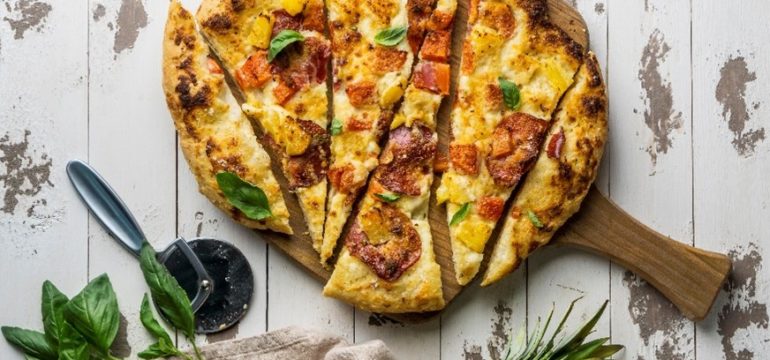By Aishwarya Badiger
They say food can bring people together; yet nothing divides a dinner table like the Hawaiian pizza. The origins of using pineapple as a pizza topping began in 1962 Canada when Sam Panopolous, a Greek chef started experimenting with new toppings due to a lack options at the time. Clearly some people loved the combination which is why it is around to this day, but some have strong oppositions against the Hawaiian pizza – from harsh chef critiques to rumors of national bans in Italy.
Pop culture and social media do play a role in biasing preferences, but why do some toppings go together with pizza better than others? What is the secret to a successful marriage of ingredients? Apart from personal preferences, there may be physicochemical reasons humans have paired certain ingredients together.
Taste contrasts
Sweet and salty taste combinations are not uncommon – salted caramel, pineapple jalapeno salsa, habanero mango sauce, peanut butter and chocolate, Garret’s cheese caramel popcorn anyone? Yumm! While there are complexities in liking associated with binary taste interactions, contrasting tastes often balance the sensation of elements in a dish.1,2 It seems plausible that the sweetness of pineapple would pair nicely with the saltiness of the pizza sauce. Evolutionarily, sweetness signals presence of an energy source to humans whereas, salt indicates a balance of electrolytes which means we may be wired to like sweet-salty combinations.3
Flavor – a multisensory experience
Taste is not the only sense that affects how we experience food. Aroma as sensed by the receptors in our nose, the physical sensations on our tongue (thick gravy vs crispy crackers), and chemesthetic sensations (for example the cooling effect of mint or spice sensations from chili peppers) together comprise a multisensory flavor experience. Not surprisingly, mouthfeel also plays an important role in food pairing. Often, high fat foods such as red meats are paired with wines which have an astringent character. Tannins and other astringent compounds in wine break down the lubricating proteins in our saliva and give the characteristic drying, puckering feeling on our tongue. These two sensations of fat and astringency can be visualized as falling on opposite ends of oral rheological spectrum4. Thus, over the course of a meal, as wine is sipped along with fat rich food, a balance between the two sensations is maintained. A similar relationship has been observed between acids and fat which is a combination reflected in the Hawaiian pizza. The acidity in the pineapple cuts through the fatty sensations from the cheese, balancing out the rheological eating experience.
The food pairing hypothesis
One of the most widely known hypothesis in this area, the food pairing theory, suggests that the more shared flavor compounds two ingredients have, the better they are liked in combination.
Cuisines around the world have starkly different ingredients that are used in recipes. A study looked at flavor pairings around the world using recipe databases5. Using a computational gastronomy approach, they discovered that Western cuisines primarily have recipes with ingredients that share flavor compounds, whereas East Asian cuisines tend to pair ingredients with fewer shared flavor compounds. For example, if you think about the ingredients used in Mac and Cheese, butter, flour, milk, cheese have a lot more similarities in flavor profiles than the ingredients you would see in Pho. However, both these dishes are well liked within the regions they originate from. While the food pairing theory is applicable in some cases, recent evidence has shown that it can be hit or miss when it comes to predicting ingredients that might go well together6. This in part is because the theory ignores the quantitative side of flavor where compound concentrations and their contribution to the overall sensory experience play a huge role in how they are perceived.


Representation of the flavor network developed by Ahn et.al.5 and an illustration of shared compounds in ingredients across different cuisines.
Source: Ahn et.al. (2011) Flavor network and the principles of food pairing5
Moving beyond flavor
Other than physicochemical basis for food pairing, cultural aspects play a huge role in consuming food the way they are. Geographical availability, seasonality, traditional cooking techniques have often driven food pairing in the past slowly moving towards perceptual pairing in recent years6.
A website built on the basis of the food pairing hypothesis allows users to create your own pairings based on ingredients you have. After playing around with it, I found that Hawaiian pizza ingredients, tomato and pineapple were listed as an “okay” match. The best pairing for pineapple was Emmentaler cheese and that for tomato was ciabatta. Despite the questionability of the hypothesis itself, it is a fun platform to explore and who knows what controversial pairings you might end up with next!
References
- Keast, R. S. J. & Breslin, P. A. S. An overview of binary taste-taste interactions. Food Qual. Prefer. 14, 111–124 (2003).
- Peter Coucquyt, Bernard Lahousse, J. L. There’s a science to food pairing, and you can learn it here. Available at: https://www.popsci.com/story/diy/best-ingredient-combinations-book/. (Accessed: 30th October 2021)
- Alkin, G. Savoring the Science of Salty and Sweet – Science and Food. Available at: https://www.scienceandfood.org/savoring-the-science-of-salty-and-sweet/. (Accessed: 30th October 2021)
- Des Gachons, C. P. et al. Opponency of astringent and fat sensations. Curr. Biol. 22, R829–R830 (2012).
- Ahn, Y. Y., Ahnert, S. E., Bagrow, J. P. & Barabási, A. L. Flavor network and the principles of food pairing. Sci. Rep. 1, 1–7 (2011).
- Spence, C. Food and beverage flavour pairing: A critical review of the literature. Food Res. Int. 133, 109124 (2020).

Aishwarya Badiger | Linkedin
SMF Blog Writer
Originally from India, Aishwarya is now a PhD Candidate at The Ohio State University studying compounds generated in milk during storage and their sensory perception. The goal of her research is to improve existing shelf-life depicting techniques as an alternative to date labels known to promote food waste. She is passionate about building a sustainable food system and hopes to use her food science skills to continue this effort in the food industry after graduation. In her free time, she likes experimenting in the kitchen with new cuisines (if only someone else could clean), reading fiction, volunteering with food recovery, and occasionally painting.






Leave a Reply